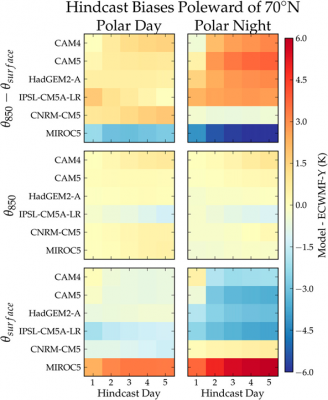Evaluating Arctic Lower Tropospheric Stability in Climate Models
The stability of the Arctic Lower Tropospheric Stability (LTS) is difficult to represent in climate models. How Arctic LTS is represented in climate models is related to how the current Arctic climate is represented and how Arctic climate is projected to change in an enhanced CO2 world. For these reasons, it is important to understand the biases in Arctic LTS. Scientists at Lawrence Livermore National Laboratory (LLNL) developed a method to analyze Arctic LTS using climate model runs in hindcast and free-running mode. The scientists analyzed National Center for Atmospheric Research’s (NCAR’s) two most recent global atmospheric models that are used for transient climate change projections, the Community Atmospheric Model Version 4 (CAM4) and Version 5 (CAM5), as well as three other models in the Coupled Model Intercomparison Project Phase 5 (CMIP5). The non-NCAR models used from CMIP5 are from the Transpose-Atmospheric Model Intercomparison Project (AMIP) experiment.
The U.S. Department of Energy (DOE) funded Cloud-Associated Parameterizations Testbed (CAPT) framework was used to evaluate the lower tropospheric stability. Hindcast simulations for the five global atmospheric models were analyzed for October 2008, January 2009, April 2009, and July 2009. The CAPT framework ensured that the dynamics and thermodynamics of the atmosphere were similar to the observations while the free running simulations were used to compare how the initial biases related to the free-running biases. Three hour temporal resolution data were compared to a re-analysis product and in-situ observations from the Department of Energy's (DOE's) station in Barrow, Alaska. The temperature biases above the inversion layer and at the surface were inter-compared between models and with clear sky and cloudy longwave radiation.
This research clearly demonstrated that the Arctic LTS biases are much more pronounced during the Arctic polar night compared to the Arctic polar day. In addition, very small temperature biases were found above the inversion, while surface temperature biases related significantly to the Arctic LTS bias. Miss-representing Arctic polar night surface temperature in climate models corresponds with the miss-representation of Arctic LTS. Longwave radiation biases were the cause of surface temperature biases, and clear-sky and cloudy sky conditions corresponded with errors in longwave radiation. During the cloudy periods, cloud liquid water was the largest contributor to biases. In addition, differences in the model's radiation code are aiding differences in the clear sky longwave fluxes.
The contribution of N.P. Barton, S.A. Klein, and J.S. Boyle to this work was performed under the auspices of the U.S. Department of Energy by Lawrence Livermore National Laboratory under contract DE-AC52-07NA27344. Support for N.P. Barton, S.A. Klein, and J.S. Boyle was provided by the Regional and Global Earth and Environmental System Modeling Programs of the Office of Science at the U. S. Department of Energy. We acknowledge the Working Group on Numerical Experiments (WGNE) and the Working Group on Coupled Modeling (WGCM) who are responsible for Transpose-AMIP II, and we thank the climate modeling groups (listed in Table 1 of this paper) for producing and making available their model output. For Transpose-AMIP II the U.S. Department of Energy's Program for Climate Model Diagnosis and Intercomparison (PCMDI) provides coordinating support and led development of software infrastructure in partnership with the Global Organization for Earth System Science Portals.

